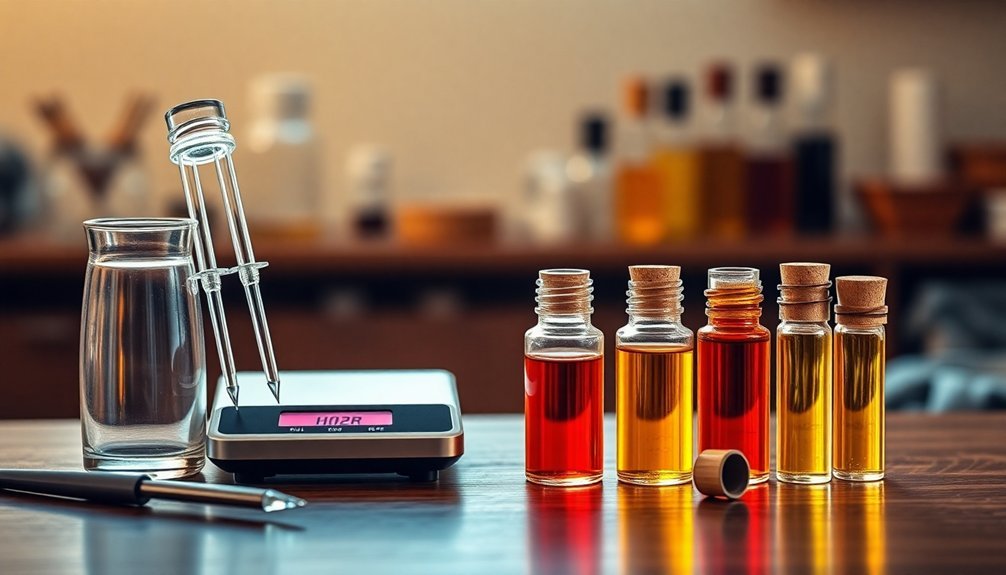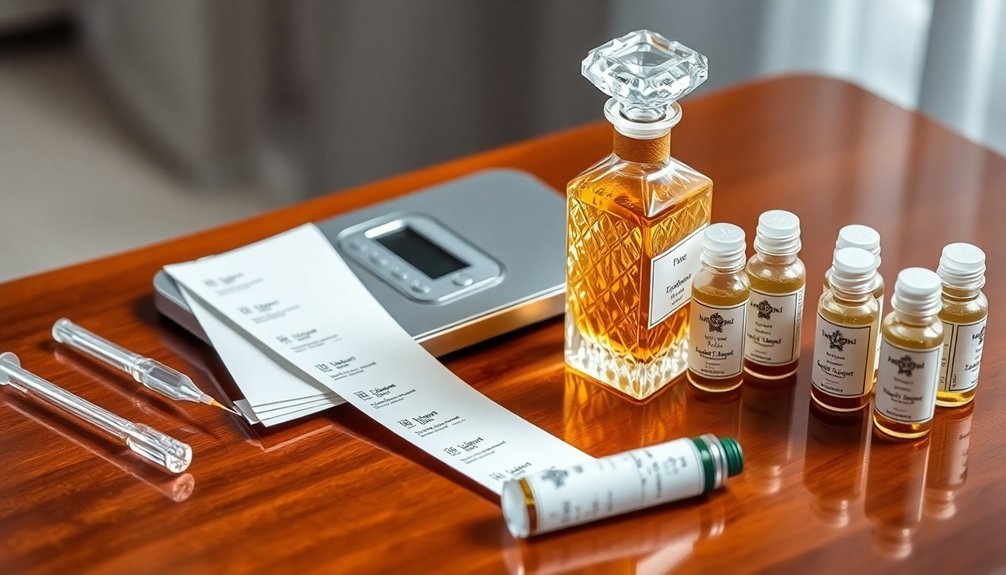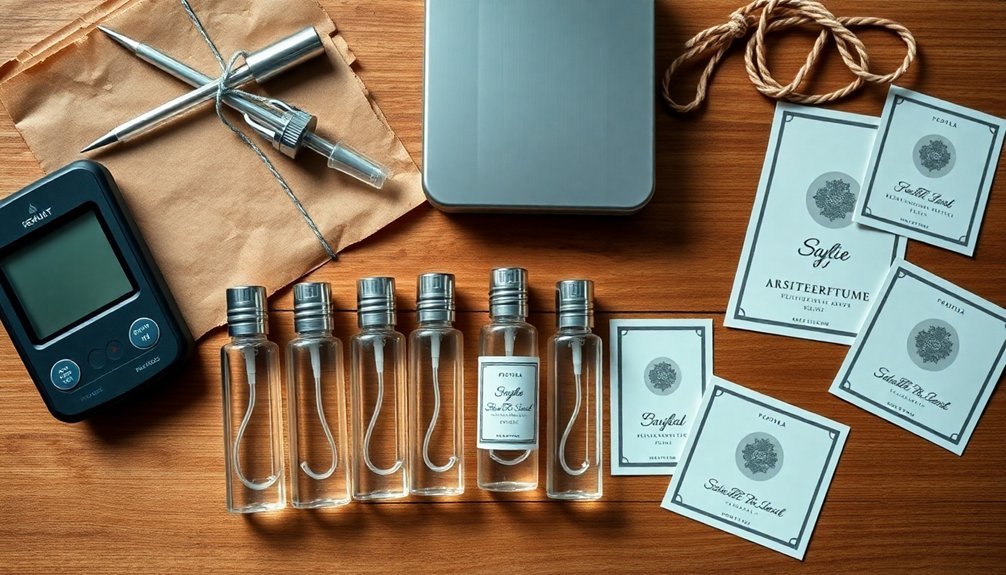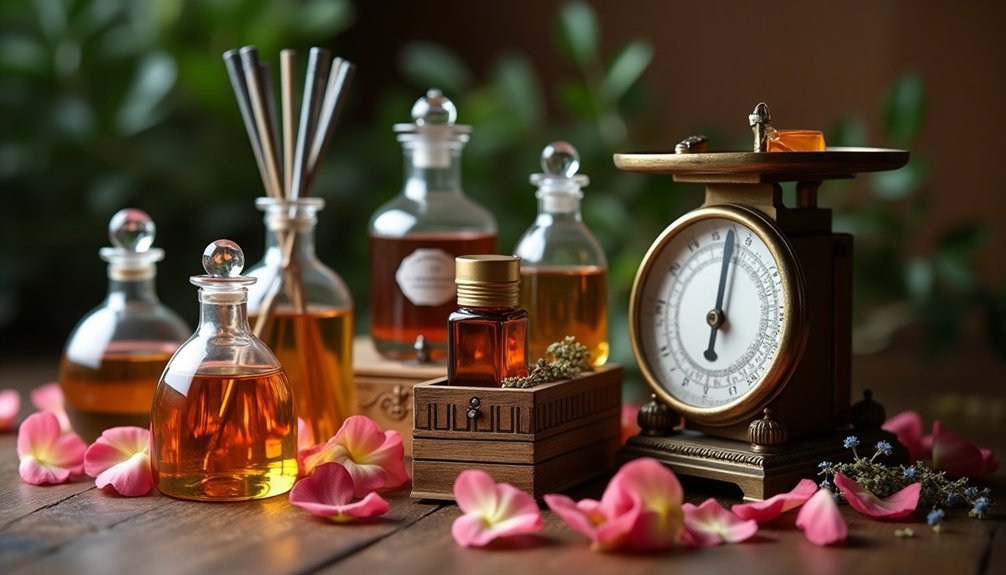You'll need several essential tools to create professional perfumes: a digital scale measuring to 0.00, glass measuring cylinders, borosilicate beakers, and precision droppers for accurate measurements. Dark glass containers and temperature-controlled storage (55-60°F) protect your fragrances, while safety equipment like nitrile gloves and goggles guarantees proper handling. Test strips and evaluation tools help perfect your scents. Understanding the complete toolkit will transform your perfume-making journey from amateur to professional.
Essential Measuring Tools for Perfect Precision

When creating perfumes, precision in measurement can make the difference between a masterpiece and a mishap.
You'll need a range of specialized tools to guarantee accuracy in every step of your perfume-making process.
Start with a digital scale that measures to the hundredths (0.00) for precise ingredient weighing, ideally one that handles up to 200 grams for small batches or 500 grams for larger production.
For liquids, you'll want glass measuring cylinders and a 4-cup Pyrex measuring cup as your foundation. Using borosilicate beakers ensures accurate dilution measurements and chemical resistance.
Don't forget essential tools like graduated cylinders for exact measurements and precision droppers.
Glass pipettes are superior to plastic ones for durability and accuracy.
For the most precise measurements of small quantities, use Monprene droppers with measurement markings for your diluted aromatics.
Storage Solutions for Fragrance Protection
Your perfume-making ingredients and final creations need proper storage in dark glass containers that block harmful UV rays and prevent degradation.
You'll want to maintain consistent temperatures between 55-60°F (13-15°C) using temperature-controlled cabinets or dedicated beauty fridges to protect your fragrances from molecular breakdown.
Always verify your storage containers have airtight seals to prevent oxidation and evaporation, which can greatly alter your perfume's composition. Keep your fragrances away from the bathroom's high humidity which can compromise their chemical stability.
Dark Glass Container Benefits
Dark glass containers stand as one of the most essential investments you'll make for preserving your handcrafted perfumes.
These containers offer superior protection against UV light, which can break down fragrance molecules and alter your carefully crafted scent profiles. The dark glass not only protects against photodegradation but also helps maintain consistent temperature and prevents oxidation. Historically, these bottles have been used for storing precious substances in apothecaries and perfume houses for centuries.
Here's why you'll want to use dark glass containers:
- They block harmful UV rays that can degrade essential oils and other light-sensitive ingredients.
- Their airtight seals prevent oxidation and moisture intrusion, extending your perfume's shelf life.
- The dark glass provides better durability and scratch resistance compared to clear containers.
- You'll benefit from the premium aesthetic that dark bottles provide, adding sophistication to your creations.
Temperature Control Matters
Proper temperature control serves as a cornerstone in preserving your perfume's quality and longevity. You'll want to maintain temperatures between 15-20°C (59-68°F) to protect your fragrances from degradation. Keep your perfumes away from direct sunlight, radiators, and bathroom environments where temperature fluctuations can break down fragrance molecules.
| Storage Location | Temperature Stability | Recommendation |
|---|---|---|
| Basement | High | Excellent Choice |
| Interior Closet | Medium | Good Option |
| Bathroom | Low | Avoid |
For ideal preservation, consider investing in temperature-controlled storage solutions. A dedicated cabinet or repurposed wine refrigerator can provide the stable environment your perfumes need. If you're working with a simpler setup, store your fragrances in cool, dark drawers away from external walls, where they'll be protected from harmful temperature variations and UV exposure.
Airtight Seals Essential
While creating beautiful fragrances requires skill and precision, protecting them demands equally careful attention to storage.
You'll need airtight containers to preserve your perfumes' integrity and prevent oxidation. The best storage options are original perfume bottles with tight seals and quality spray heads, but you can also use glass containers with secure closures if you need to transfer your creations.
Here's what you'll need for proper fragrance storage:
- High-quality glass bottles with airtight screw-top caps or stoppers
- Disposable plastic pipettes for precise, clean transfers
- Original perfume packaging with intact spray mechanisms
- Dark or opaque glass containers to shield from light
Remember to keep your bottles tightly sealed when not in use, and make any necessary transfers quickly to minimize air exposure.
Safety Equipment and Handling Supplies
You'll need essential protective gear including nitrile gloves, safety goggles, and a lab coat when working with fragrance materials to prevent skin contact and chemical exposure.
Keep metal spatulas and specialized tools handy for safely handling various ingredients, from powders to waxy substances.
Your workspace must include proper safety equipment like eye wash stations and adequate ventilation, with immediate access to safety showers at loading areas to manage any accidental spills.
Protective Gear Essentials
Safety in perfume making demands rigorous attention to protective equipment and handling supplies.
You'll need to guarantee you've got the right gear to protect yourself from chemical exposure and potential hazards while working with fragrance materials.
- Start with high-quality nitrile gloves and a lab coat or apron to protect your skin from direct contact with chemicals.
- Wear safety goggles and appropriate respiratory protection when handling volatile compounds.
- Install proper ventilation systems and maintain accessible emergency equipment like eye wash stations and safety showers.
- Keep a fire extinguisher nearby and guarantee your workspace has anti-static protection measures in place.
Remember to regularly inspect your safety equipment and keep Safety Data Sheets readily available for all materials you're working with.
Proper protective gear isn't optional—it's essential for your safety and professional practice.
Safe Material Handling Protocols
Building upon proper protective gear, implementing robust material handling protocols creates a secure foundation for perfume making.
You'll need proper emergency response equipment, including safety showers and eye baths strategically positioned near your work area. Keep tank-fed systems with heated water ready for immediate chemical exposure response.
Install mechanical guards on any equipment with moving parts like blades or belts, and make certain they're properly secured with sturdy materials.
You'll also need proper electrical safety components, including certified circuit breakers and grounding equipment. For fire prevention, incorporate anti-static materials and ventilation systems, especially when working with flammable ingredients.
Don't forget to mount easily accessible emergency stop devices near your workstation. Regular inspection and maintenance of these safety systems is essential for maintaining a secure perfume-making environment.
Fragrance Testing and Evaluation Equipment

When crafting perfumes, having the right testing and evaluation equipment is essential for ensuring consistent, high-quality results.
You'll need reliable tools to assess your fragrances accurately and maintain quality control throughout the creation process.
- Test strips and blotters (5" x 1⁄2") let you evaluate the full complexity of your scents, from top notes to base notes, while comparing different fragrances side by side.
- Automated evaluation systems measure key properties like density and color with minimal sample volume, reducing human error.
- Olfactory evaluation cabinets simulate real-world conditions and provide a neutral testing environment with temperature and humidity control.
- Supporting equipment includes disposable pipettes for precise transfers, glass measuring tools for accurate blending, and digital scales for exact measurements.
Quality Control and Preservation Essentials
Beyond testing equipment, maintaining impeccable quality control and preservation standards will determine your perfume's ultimate success. You'll need specific tools and equipment to authenticate ingredients, detect adulterants, and guarantee batch consistency. GC-FID and GC-MS systems are essential for analyzing chemical profiles and identifying compounds.
| Quality Control Tool | Primary Function |
|---|---|
| Chemical Profile Kit | Verify ingredient authenticity |
| Digital Temperature Logger | Monitor storage conditions |
| Batch Testing Equipment | Guarantee production consistency |
| Stability Testing Chamber | Assess longevity and durability |
| Preservation System | Maintain fragrance integrity |
For proper preservation, you'll need specialized storage containers that protect against light, heat, and humidity. Don't forget to invest in high-quality sealing equipment and temperature-controlled storage units. These tools will help you maintain consistent quality and extend your perfume's shelf life while protecting its unique characteristics.
Professional Bottling and Packaging Tools

Professional bottling and packaging tools represent the final gateway between your perfume creation and market success.
You'll need reliable crimping tools and presses to guarantee your bottles are properly sealed, while high-quality packaging materials protect and showcase your fragrances.
- Start with essential bottling equipment like hand-held crimping tools for small batches or manual crimping machines for larger production runs.
- Choose from glass, plastic, or metal containers based on your brand's aesthetic and target market.
- Enhance your packaging with premium accessories like magnetic closures, silk-lined inserts, and protective foam dividers.
- Consider specialized designs like collapsible rigid boxes with custom fittings to elevate your presentation.
These tools will help you achieve professional-grade bottling and create packaging that captures your brand's essence while protecting your precious fragrances.
Frequently Asked Questions
How Often Should Perfume-Making Tools Be Cleaned and Sterilized?
You'll need to clean your perfume-making tools after each use with soapy water, and sterilize them with ethanol. Don't skip regular inspections, and increase cleaning frequency when working with strong fragrances.
What Alternative Tools Can Beginners Use Before Investing in Professional Equipment?
You can start with kitchen measuring cups, small glass jars, eyedroppers from pharmacies, and coffee filters. Don't forget to use household gloves and simple face masks for safety while experimenting.
Which Tools Are Absolutely Necessary for Creating Small Test Batches?
You'll need precision digital scales, glass pipettes, small glass containers, measuring cups, scent strips, and protective gloves. Don't forget labels and a notebook to track your formulas while making test batches.
Can Household Items Substitute for Professional Perfume-Making Tools?
You can substitute common kitchen items like measuring spoons, glass jars, and eye droppers for basic perfume making. However, you'll need proper pipettes and beakers for more precise, professional results.
What's the Typical Cost Range for a Basic Perfume-Making Toolkit?
You'll need to budget between $150-300 for a basic perfume-making toolkit, including digital scales, beakers, pipettes, bottles, and protective gear. Add-on supplies like fragrance oils cost extra.
In Summary
You'll find that investing in these professional perfume-making tools elevates your craft from a hobby to an art form. With precise measuring equipment, proper storage solutions, safety gear, testing tools, quality control supplies, and bottling accessories, you're well-equipped to create signature fragrances. Don't skimp on these essentials – they're vital for achieving consistent, high-quality results that meet professional standards in perfumery.





Leave a Reply